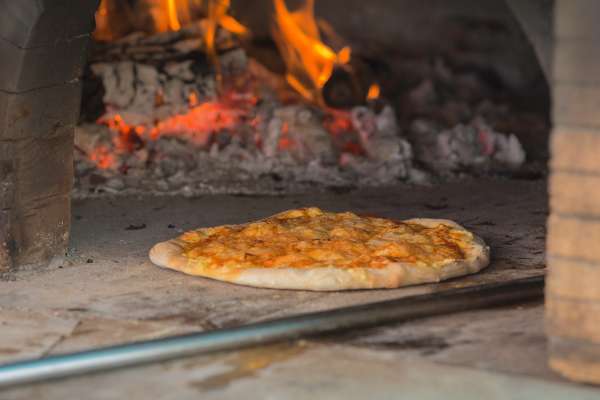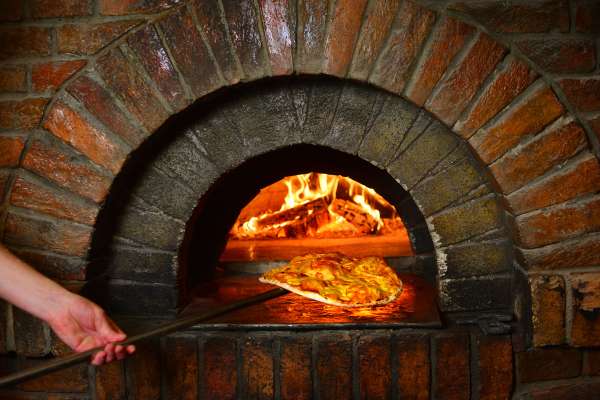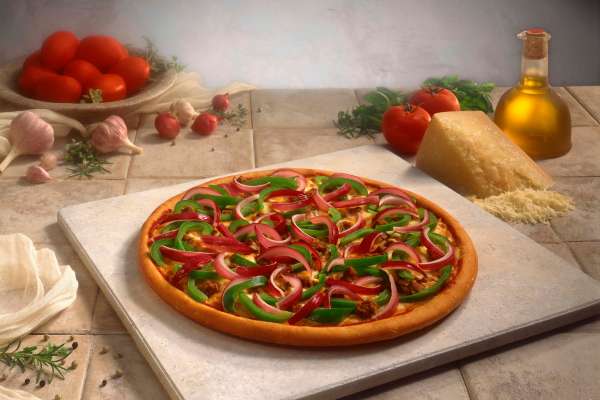A pizza stone is a baking tool, often made from cordierite, ceramic, or clay, designed to replicate the cooking conditions of a brick oven. This kitchen accessory is shaped like A flat stone disc that absorbs And distributes heat evenly, Which allows it to create the perfect conditions for baking pizza. It aids in producing A crispy crust by drawing moisture out Of the dough during baking. Furthermore, Its porous nature enhances the overall flavor Of the pizza. These are not limited to pizzas alone, They can Be used for baking bread, cookies, And other pastries. They come in various shapes and sizes, catering to different oven dimensions And individual preferences.
What Is A Pizza Stone Made Of?

This is typically made from either cordierite, ceramic, Or clay, materials that are excellent at withstanding high temperatures And evenly distributing heat. Cordierite stones are highly resistant to thermal shock, Making them A popular choice. They can handle dramatic changes in temperature without cracking. Ceramic stones, Often glazed for durability And ease of cleaning, Are also commonly used due to their excellent heat retention and distribution qualities. Lastly, Clay pizzas stones are valued for their porous nature, absorbing moisture from the dough to create A crispier crust. Some modern pizzas stones may also be made from steel Or cast iron, Which have their own unique heat-conductive properties.
What’s The Best Material For A Pizza Stone?
Determining the best material for A pizzas stone largely depends On your specific needs And preferences. However, cordierite stones are often favored for their superior thermal shock resistance, Meaning they can handle extreme temperature changes without cracking, Making them ideal for grilling Or broiler usage as well as oven use.
Ceramic stones, On the other hand, Are popular for their excellent heat retention And distribution, Though they may be A bit more prone to cracking under extreme temperature changes. Some enthusiasts swear by steel “stones,” Which, although they’re not traditional, can absorb and transfer heat incredibly efficiently, Often preheating faster and delivering A well-cooked crust in a shorter time.
Lastly, Cast iron options offer great heat retention And durability, Though they may not draw as much moisture from the dough, resulting in A slightly less crispy crust. Your choice should take into consideration factors like cooking method, Desired crust crispness, And overall durability.
The Essence Of A Pizza Stone

The essence of A pizza stone lies in its ability to emulate the conditions of A brick oven, providing An optimal environment for baking pizzas And similar items. Made from materials like cordierite, ceramic, Or clay, A stone absorbs And evenly distributes the heat from your oven, Reducing hot spots that can cause uneven cooking Or burning. It also absorbs moisture from the dough during baking, leading to A perfectly crispy crust. More than A mere cooking accessory, A pizza stone enhances the overall culinary experience by contributing to the flavor, texture, And authenticity Of home-baked pizzas, embodying the true essence Of traditional pizza making. It is A testament to the art Of baking, capturing the heart Of timeless cooking traditions while enabling anyone to create high-quality pizzas right in their own kitchen.
History Of Pizza Stones

The history Of stones is deeply rooted in the traditional baking methods used thousands Of years ago. Early civilizations used stones Or ceramic pieces heated by fire to cook flatbreads And other foods. This technique was honed over centuries, Particularly in regions like Italy where pizzas was born.
The modern pizza stone, As we know it, emerged more recently As An answer to the challenge of replicating the conditions of professional, high-heat brick ovens in home kitchens. As pizza’s popularity spread globally in the 20th century, So did the desire to perfect homemade pizzas baking.
This led to the creation and commercialization Of stones, Designed to provide even, intense heat and moisture absorption, essential for achieving A crispy, well-baked crust. Today, these stones come in various materials such as cordierite, ceramic, Or clay, each adding A unique touch to the art Of pizzas making.
Types Of Pizza Stones
1. Ceramic

Ceramic pizza stones are A popular choice for many home chefs due to their excellent heat retention And distribution capabilities. Made from fired clay, They can reach And maintain high temperatures effectively, Thus contributing to A well-cooked, crispy pizzas crust. These stones are generally inexpensive and widely available. However, They can Be slightly more prone to cracking compared to other materials, Particularly under rapid temperature changes.
2. Cordierite

Cordierite is A mineral known for its superior thermal shock resistance. This means that pizza stones made from cordierite can endure dramatic changes in temperature without cracking, Which makes them ideal for both oven and grill use. While cordierite stones may take A bit longer to heat up compared to steel or ceramic, They provide excellent heat distribution And retention once they reach the desired temperature. Their robust nature And high-quality performance make them A preferred choice among many pizzas enthusiasts.
3. Steel

Actually baking plates rather than stones, These steel variants are prized for their incredibly efficient heat transfer. They typically preheat faster than their stone counterparts And can cook a pizzas in A shorter time, Resulting in A well-browned, crispy crust. Steel “stones” are also practically indestructible, withstanding very high temperatures without any risk of cracking. However, They tend to be heavier And more expensive than ceramic Or cordierite stones, And they don’t absorb moisture from the dough, which might impact the texture Of the crust slightly.
Why Use A Pizza Stone?
A pizza stone is An indispensable tool for those seeking To achieve the perfect homemade pizzas, akin to what you’d find in A professional pizzeria. It effectively replicates the conditions Of a brick oven in A regular home oven by absorbing and distributing heat evenly across the surface Of the pizzas.
This helps avoid undercooked areas Or hot spots that can occur in standard ovens, ensuring A uniformly cooked pizza. Its porous nature is another key advantage, Absorbing moisture from the pizza dough to yield A crisp, well-browned crust that’s hard to achieve with A normal baking sheet.
Beyond pizzas, A stone can enhance the baking Of bread, pastries. And other goods by offering the same benefits Of even heat And moisture absorption. Thus, using A pizzas stone elevates the overall baking experience, bringing professional-grade results to the comfort Of home kitchens.
How To Use A Pizza Stone
1. Preheating The Stone

Using a pizzas stone requires some preplanning, As the stone needs to Be thoroughly preheated before use. It’s recommended to place the stone in A cold oven and then set the oven to the highest setting. Usually between 450 to 500 degrees Fahrenheit (232-260 Celsius). Allow the stone to heat for at least An hour. This process ensures that the stone has absorbed enough heat to cook your pizzas effectively. Always avoid placing A cold pizza stone into A hot oven or A cold pizzas on A hot stone as the sudden temperature change could cause the stone to crack.
2. Cooking With The Stone

Once the pizzas stone is preheated, You can carefully place your prepared pizzas onto it. Using A pizza peel can make this task easier. Bake the pizzas according to your recipe’s instructions, keeping A close eye on it. As cooking times can vary based on the thickness Of the dough and the oven’s temperature. The high, Even heat from the stone will cook the pizza evenly And help achieve a crispy crust. Also, remember that the stone will remain hot for a while after coming out of the oven. So always use oven mitts And allow it to cool before handling.
3. Cleaning And Maintenance
After use, Let the pizzas stone cool completely before cleaning it. Most pizzas stones are porous, Which means they’ll absorb soap, So it’s best to avoid using detergents. Instead, use A dry or slightly damp cloth to wipe off any leftover food particles. For stubborn stains, A bit of baking soda and water can be used as A gentle abrasive. Remember never to soak the stone in water, As it can absorb moisture And potentially crack when next heated. With proper care, A pizzas stone can last for many years, Enhancing your homemade pizza experience.
Benefits And Drawbacks
- Even Heat Distribution: Pizza stones provide even heat distribution, Preventing hot spots and ensuring uniformly cooked pizzas.
- Moisture Absorption: The porous material of A pizzas stone absorbs moisture from the pizzas dough, resulting in A crispy, well-baked crust.
- Versatility: Beyond pizzas, Pizza stones can be used to bake bread, cookies, And other pastries, improving their texture and flavor.
- Improved Flavor: Some users believe that over time. The pizzas stone can enhance the flavor Of pizzas as it absorbs the flavors from previous bakes.
- Emulates Brick Oven Baking: A pizzas stone can replicate the high-heat conditions of A traditional brick oven in A regular home oven Or grill.
Drawbacks
- Preheating Time: Pizzas stones require significant preheating time, typically An hour, Which can increase overall cooking time.
- Risk of Cracking: If not properly preheated Or cleaned, pizzas stones, particularly ceramic ones, Are susceptible to thermal shock and may crack.
- Weight: Pizza stones can Be heavy and bulky, making them more difficult to handle and store.
- Cleaning: As pizzas stones are porous and absorbent, They can stain easily And require careful cleaning without detergents.
- No direct flame: Pizzas stones should not be exposed to direct flame, limiting their use in certain types Of grills Or fire pits.
Where To Buy A Pizza Stone
Pizza stones are widely available and can Be purchased from various outlets. You can find them in kitchenware stores, department stores, And even some supermarkets with extensive homeware sections. They are also available from online marketplaces such as Amazon, eBay, And Walmart’s online store. Where you’ll often find A larger selection of brands, sizes, And materials.
Specialty kitchen and cooking retailers like Williams-Sonoma Or Bed Bath & Beyond also carry A range of pizza stones. Additionally, many pizzas And baking specialty stores, both physical and online, offer pizzas stones. When purchasing, consider the size of your oven to ensure the stone fits well. And review user ratings And feedback if available to gauge the stone’s performance and durability.
The Final Thoughts
A pizza stone is A kitchen tool designed to replicate the high-heat. Even-cooking conditions of a brick oven in A home kitchen or grill setting. It is typically made from materials like cordierite, ceramic. Or clay, which absorb and distribute heat uniformly, reducing hot spots and ensuring A well-cooked pizza. The porous nature of these materials also helps absorb moisture from the dough, yielding A crispier crust. These stones come in various sizes to fit different ovens, and while they are primarily used for baking pizzas. They can also enhance the cooking of bread, cookies, And other pastries. By providing a surface that absorbs and maintains heat exceptionally well, a pizzas stone allows home chefs to bake pizzas that rival those of professional pizzerias.
